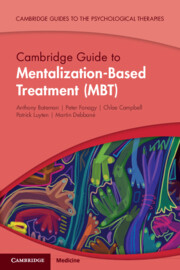Book contents
- Cambridge Guide to Mentalization-Based Treatment (MBT)
- Cambridge Guides to the Psychological Therapies
- Reviews
- Cambridge Guide to Mentalization-Based Treatment (MBT)
- Copyright page
- Contents
- Preface
- A Note from the Series Editor
- Acknowledgments
- Part I Overview of the Model
- Part II The Mentalization-Based Treatment Model in Practice
- Part III Application and Adaptations for Mental Health Presentations
- Part IV Application of Mentalization-Based Treatment in Different Populations and in Different Settings
- Chapter 13 Working with Children
- Chapter 14 Working with Adolescents
- Chapter 15 Working with Families
- Chapter 16 Working with Couples
- Chapter 17 Mentalizing in Other Settings
- Chapter 18 Mentalizing and Emergency Care
- Index
- References
Chapter 18 - Mentalizing and Emergency Care
from Part IV - Application of Mentalization-Based Treatment in Different Populations and in Different Settings
Published online by Cambridge University Press: 18 May 2023
- Cambridge Guide to Mentalization-Based Treatment (MBT)
- Cambridge Guides to the Psychological Therapies
- Reviews
- Cambridge Guide to Mentalization-Based Treatment (MBT)
- Copyright page
- Contents
- Preface
- A Note from the Series Editor
- Acknowledgments
- Part I Overview of the Model
- Part II The Mentalization-Based Treatment Model in Practice
- Part III Application and Adaptations for Mental Health Presentations
- Part IV Application of Mentalization-Based Treatment in Different Populations and in Different Settings
- Chapter 13 Working with Children
- Chapter 14 Working with Adolescents
- Chapter 15 Working with Families
- Chapter 16 Working with Couples
- Chapter 17 Mentalizing in Other Settings
- Chapter 18 Mentalizing and Emergency Care
- Index
- References
Summary
Emergency care teams need to organize their response to crises around shared assessment procedures. This chapter describes how MBT can inform emergency care when a crisis is handled by the multidisciplinary team of mental health practitioners in psychiatric emergency settings. Development of the formulation according to mentalizing principles creates compassionate care in emergency settings. The chapter outlines the key factors that commonly contribute to the development of a crisis, and includes a discussion of the centrality of loss of mentalizing and collapse of agency of the self that are part of any acute crisis. Focusing on all of these aspects of a psychiatric emergency can de-escalate an immediate crisis and pave the way for planning how to prevent a recurrence in the future. Understanding of the triggers that can lead to a crisis and development of a plan for reducing the risk of recurrence are illustrated with clinical examples, and the four steps of MBT-informed emergency care are described.
- Type
- Chapter
- Information
- Cambridge Guide to Mentalization-Based Treatment (MBT) , pp. 364 - 387Publisher: Cambridge University PressPrint publication year: 2023



